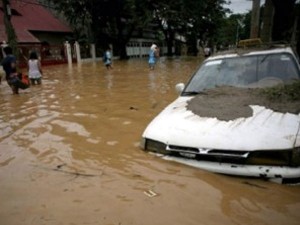Businesses urged to acquire Disaster Recovery Plan

Residents evacuate themselves and their belongings from their houses inside Provident Village in Marikina City as Typhoon Ondoy brought heavy rains in Metro Manila on Sept. 26, 2009. INQUIRER FILE PHOTO
MANILA, Philippines – In a country pelted by an average of 20 typhoons every year, the resulting floodwaters and power outages are two of the problems that even businesses are worried about.
It turns out that planning ahead of a disaster can help save companies in the Philippines from damaging their IT hardware, data, and even their reputation.
This is why businesses should acquire a Disaster Recovery Plan (DRP) that will allow them to prepare for the rainy season and other disasters, according to DataOne Asia Philippines, provider of managed IT services to enterprises in the country.
Aside from CloudSecure™, an enterprise cloud product that was officially launched to the market last year, DataOne Asia also offers a Disaster Recovery Plan for enterprises in the Philippines.
DataOne Asia President and CEO Cyril Rocke says that to ensure business continuity in times of calamities like typhoons companies must have a DRP.
“Companies should have a DRP in place because the lack of such a plan could mean the end of a business. The DRP prevents or lessens the damages that companies can get from sudden catastrophic events.”
In a nutshell, Disaster Recovery Planning is when a company creates a backup of its IT system and files in an offsite location in preparation for both natural and accidental disasters.
While many businesses in the country are required by law to have a DRP, there are still those who overlook this important business component. Rocke says that having a DRP is a must for companies in the Philippines, which is frequented by typhoons throughout the year.
“During typhoons, we know that the streets become easily flooded. Some companies, especially those located near large bodies of water, can have their buildings infiltrated by water, which may damage servers and lead to data loss,” Rocke explains.
While servers damaged by floodwaters can be easily replaced through insurance policies, it may still take some time to restore the entire system back to normal. According to DataOne Asia Director of Operations Alex Fernando, a company may have to wait at least a month for its IT operations to resume after purchasing a new set of servers.
“Replacing damaged hardware cannot be simply done in one day or even one week. If you don’t have a DRP in place, it can take a company at least a month to buy new equipment, install programs and restore everything.”
Aside from hardware glitches, the data stored within the servers can create a worse problem for companies. Rocke says that companies without DRPs that lose data after a disaster have a high rate of failure.
“Once a company loses its precious data, it will have a hard time getting back on its feet. In fact, around 80 percent of businesses will go bankrupt in their first year or within a couple of years after a disaster,” he says.
Aside from floodwaters, another problem that might spring from severe weather disturbances is power failure. Fernando explains that typhoons can actually take a company’s entire IT system offline, which can create detrimental effects.
“When a company’s IT system is down, it means that all the applications will not be available for their use. Say that you are a logistics company that has a dysfunctional IT system because of power outage. If your system is down even for just an hour, it means you cannot book sales and orders, process inventories, and release stocks. Basically, you can’t do anything,” he says.
But one of the hardest hit that a company may take once its IT system down is brought down by disasters is permanent business loss, translated by the loss of customers’ confidence and loyalty to a company’s service.
“Once your business takes long or never recovers from a disaster, your clients will lose confidence in your service, which prompts them to move to more reliable providers. It is impossible to have your clients wait for a few weeks while you fix your system when it is so easy for them to acquire the services of another provider. The loss of business is by far the biggest consequence,” Rocke says.
When acquiring a DRP, a company needs to consider a lot of factors. For one, they have to identify which data will be backed up.
“Some companies may have the perception of saying, ‘If I have 100 servers, do I also need 100 servers in my disaster recovery site?’ I said no. You only select and back up those data that are very critical in running your business,” Fernando explains.
Another important factor that companies have to consider is the location of their disaster recovery (DR) sites. Rocke says that companies need to choose DR sites that are easily accessible.
“For example, if there’s no power in your Makati office, your DR site might be affected by the blackout if it’s in the same city. But the DR site should not be too far either. You must ensure that it is accessible, even to your employees.”
With the announcement from the Philippine Atmospheric, Geophysical & Astronomical Services Administration (Pagasa) that the rainy season has officially started, Rocke further urges companies to have a DRP.
However, he stresses that a DRP is not something that companies should only avail of during the rainy season, as disasters can strike anytime.
“While typhoons typically come during the rainy season, there are disasters like earthquakes and even building fires that can occur anytime. Think of a Disaster Recovery Plan as your business’ life insurance. It’s something that you need to have in order to protect your company.”














